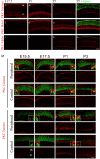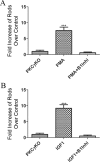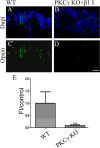Specific protein kinase C isoforms are required for rod photoreceptor differentiation
- PMID: 22171059
- PMCID: PMC3256583
- DOI: 10.1523/JNEUROSCI.2578-11.2011
Specific protein kinase C isoforms are required for rod photoreceptor differentiation
Abstract
The protein kinase C (PKC) family of enzymes regulates cell physiology through phosphorylation of serine and threonine residues of many proteins in most cell types. Here we identify PKC-β1 and PKC-γ as isoforms that are essential for rod photoreceptor differentiation in mouse retinas. Using ex vivo retinal explants, we found that phorbol ester 12-myristate 13-acetate and insulin-like growth factor 1 (IGF1) induced rod differentiation, as defined by opsin or Crx expression, in a PKC-dependent manner days ahead of rod development in untreated explants. PKC-β1 and PKC-γ were colocalized with proliferating cell nuclear antigen (PCNA)- and STAT3-positive progenitors through the later differentiation period. Pharmacological or genetic inhibition of either isoform resulted in a partial reduction in the appearance of rods, whereas removing both isoforms resulted in their complete absence. Furthermore, a significant decline of STAT3 tyrosine phosphorylation was observed by activation of PKC, while inhibition of PKC resulted in an increase of phosphorylated STAT3 along with a delayed cell cycle exit of progenitors with prolonged PCNA expression. In adult retinas, IGF1 activates PI-3 kinase (PI3K), but in neonatal retinas its action is identical to the action of an PI3K inhibitor. These data unveil a novel signaling cascade that coordinates and regulates rod differentiation through specific PKC isoforms in mammals.
Figures












Similar articles
-
Protein kinase C regulates rod photoreceptor differentiation through modulation of STAT3 signaling.Adv Exp Med Biol. 2010;664:21-8. doi: 10.1007/978-1-4419-1399-9_3. Adv Exp Med Biol. 2010. PMID: 20237998
-
Fatty acid and phorbol ester-mediated interference of mitogenic signaling via novel protein kinase C isoforms in pancreatic beta-cells (INS-1).J Mol Endocrinol. 2003 Jun;30(3):271-86. doi: 10.1677/jme.0.0300271. J Mol Endocrinol. 2003. PMID: 12790799
-
Cytokine-induced activation of signal transducer and activator of transcription in photoreceptor precursors regulates rod differentiation in the developing mouse retina.J Neurosci. 2004 Nov 3;24(44):9779-88. doi: 10.1523/JNEUROSCI.1785-04.2004. J Neurosci. 2004. PMID: 15525763 Free PMC article.
-
Protein kinase C-alpha isoform is involved in erythropoietin-induced erythroid differentiation of CD34(+) progenitor cells from human bone marrow.Blood. 2000 Jan 15;95(2):510-8. Blood. 2000. PMID: 10627456
-
PKC and the control of localized signal dynamics.Nat Rev Mol Cell Biol. 2010 Feb;11(2):103-12. doi: 10.1038/nrm2847. Nat Rev Mol Cell Biol. 2010. PMID: 20094051 Review.
Cited by
-
Heteromeric MT1/MT2 melatonin receptors modulate the scotopic electroretinogram via PKCζ in mice.Exp Eye Res. 2018 Dec;177:50-54. doi: 10.1016/j.exer.2018.07.026. Epub 2018 Jul 27. Exp Eye Res. 2018. PMID: 30059666 Free PMC article.
-
Mitochondrial Uncoupling Protein 2 Knock-out Promotes Mitophagy to Decrease Retinal Ganglion Cell Death in a Mouse Model of Glaucoma.J Neurosci. 2019 May 1;39(18):3582-3596. doi: 10.1523/JNEUROSCI.2702-18.2019. Epub 2019 Feb 27. J Neurosci. 2019. PMID: 30814312 Free PMC article.
-
Immunocytochemical Profiling of Cultured Mouse Primary Retinal Cells.J Histochem Cytochem. 2017 Apr;65(4):223-239. doi: 10.1369/0022155416689675. Epub 2017 Feb 2. J Histochem Cytochem. 2017. PMID: 28151698 Free PMC article.
-
Cell Autonomous Neuroprotection by the Mitochondrial Uncoupling Protein 2 in a Mouse Model of Glaucoma.Front Neurosci. 2019 Mar 8;13:201. doi: 10.3389/fnins.2019.00201. eCollection 2019. Front Neurosci. 2019. PMID: 30906248 Free PMC article.
-
Regulation of rod photoreceptor differentiation by STAT3 is controlled by a tyrosine phosphatase.J Mol Neurosci. 2015 Jan;55(1):152-159. doi: 10.1007/s12031-014-0397-1. Epub 2014 Aug 10. J Mol Neurosci. 2015. PMID: 25108518 Free PMC article.
References
-
- Altshuler D, Cepko C. A temporally regulated, diffusible activity is required for rod photoreceptor development in vitro. Development. 1992;114:947–957. - PubMed
-
- Altshuler D, Lo Turco JJ, Rush J, Cepko C. Taurine promotes the differentiation of a vertebrate retinal cell type in vitro. Development. 1993;119:1317–1328. - PubMed
-
- Ananthanarayanan B, Stahelin RV, Digman MA, Cho W. Activation mechanisms of conventional protein kinase C isoforms are determined by the ligand affinity and conformational flexibility of their C1 domains. J Biol Chem. 2003;278:46886–46894. - PubMed
-
- Asao H, Fu XY. Interferon-gamma has dual potentials in inhibiting or promoting cell proliferation. J Biol Chem. 2000;275:867–874. - PubMed
-
- Asotra K, Macklin WB. Developmental expression of protein kinase C isozymes in oligodendrocytes and their differential modulation by 4 beta-phorbol-12,13-dibutyrate. J Neurosci Res. 1994;39:273–289. - PubMed
Publication types
MeSH terms
Substances
Grants and funding
LinkOut - more resources
Full Text Sources
Molecular Biology Databases
Research Materials
Miscellaneous
